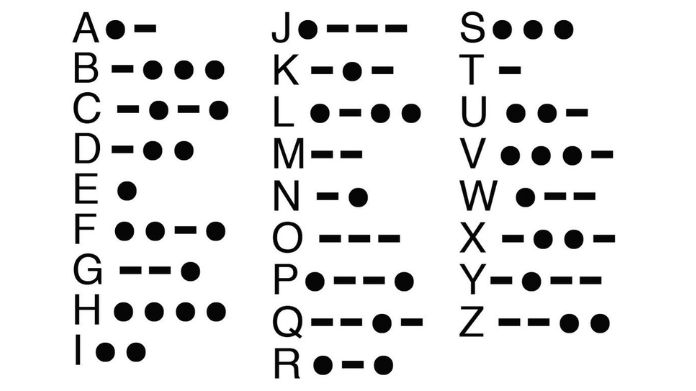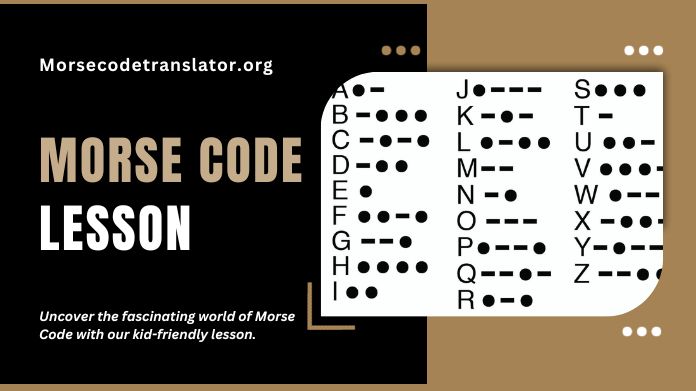Morse Code is a fascinating and enduring method that transcends language barriers in the vast communication landscape. While it might seem like a relic from the past, Morse Code has an intriguing history and continues to captivate the curious minds of today, even inspiring the imaginations of the youngest learners.
This Morse Code Translator guide, “Morse Code Lesson for Kids: History, Alphabet, and Facts,” is a journey into the world of dots and dashes, unlocking the secrets of this ingenious coding system.
Designed especially for young minds, this lesson is not just about learning a series of beeps and blinks but understanding the language that once connected distant places and saved lives.
Join us as we explore the rich history of Morse Code Lesson, decode its alphabet, and unearth interesting facts that make learning this timeless communication method an exciting adventure for kids.
From its invention by Samuel Morse to its role in crucial moments in history, the Morse Code has become more than just a set of symbols—it has become a window into a world where communication knew no bounds.
Let’s embark on this educational exploration, where dots and dashes come together to tell a story of ingenuity and connection through Morse Code Lesson.
History of Morse Code

Morse Code is a form of communication that uses a series of dots and dashes to represent letters and numbers. Samuel Morse and Alfred Vail developed it in the 1830s and 1840s to send messages over long distances using telegraph lines.
The code is named after Samuel Morse, an American inventor and artist who co-invented the telegraph and developed the code for use. Morse Code quickly became the standard for telegraph communication, allowing messages to be sent and received using a simple system of long and short signals.
The basic unit of Morse Code is the “dot” or short signal, which represents the letter “E”. The “dash” or long signal means the letter “T”. Combining dots and dashes can define all letters of the alphabet, numbers, and punctuation marks.
Morse Code was widely used throughout the 19th and 20th centuries, particularly for maritime communication. It was crucial in transmitting distress signals, such as the famous SOS signal, represented in Morse Code as “… — …”.
Morse Code has a rich history and has played a significant role in developing long-distance communication. Its simplicity and efficiency continue to make it a fascinating and enduring method of communication.
What is the Morse Code Alphabet?
The Morse Code Alphabet represents letters, numbers, and punctuation marks using a combination of dots and dashes. Samuel Morse and Alfred Vail developed it in the early 1830s to communicate for telegraph systems.
Each letter or symbol in the alphabet is represented by a specific sequence of short and long signals, with spaces between each letter and word.
The Morse Code Alphabet is still used in particular fields, such as aviation and amateur radio, and is also recognized as a historic communication method.
Morse Code Lesson for Kids

Morse Code is a communication system that uses a series of dots and dashes to represent letters, numbers, and symbols. Samuel Morse and Alfred Vail invented it in the early 1830s. It was initially used for long-distance communication over telegraph lines, but it is still used today by amateur radio operators and in some military applications.
To understand Morse Code, you must learn the basic patterns for each letter, number, and symbol. The dot represents a short signal, while the dash represents a more extended signal. For example, A is represented by a dot followed by a dash, while a dash followed by three dots represents B.
Here are the Morse Code patterns for the letters of the alphabet:
A: .- N: -. 0: —–
B: -… O: — 1: .—-
C: -.-. P: .–. 2: ..—
D: -.. Q: –.- 3: …–
E: R: .-. 4: ….-
F: ..-. S: … 5: …..
G: –. T: – 6: -….
H: …. U: ..- 7: –…
I: .. V: …- 8: —..
J: .— W: .– 9: —-.
K: -.- X: -..-
L: .-.. Y: -.–
M: — Z: –..
To practice Morse Code, you can use a flashlight to send signals by turning it on and off. You can also use an app or a website that allows you to type in text and have it translated into Morse Code. Try sending messages to your friends or family and see if they can decode them!
Learning Morse Code can be a fun and educational activity for kids. It teaches them about an essential part of communication history and helps them develop their listening and decoding skills.
Final Note
And that wraps up our journey into the world of Morse Code Lesson! We’ve discovered how this unique code of dots and dashes wasn’t just about beeping sounds but was a clever way people used to talk to each other from far away.
We’ve learned a lot from the incredible history of Samuel Morse creating it and how Morse Code played a big part in essential times. The Morse Code alphabet has become a secret language that helps us understand the past and how people sent messages when there were no phones or computers.
So, as we finish our Morse Code lesson, remember that dots and dashes hold stories and secrets. They’re like a unique key that opens doors to a time when messages travelled through the air in beeps and blinks. Keep curious, and who knows what other cool things you might discover!
So, give it a try and start exploring the world of Morse Code!
